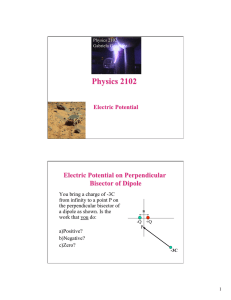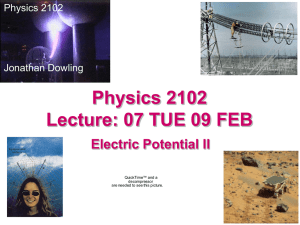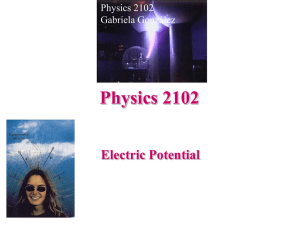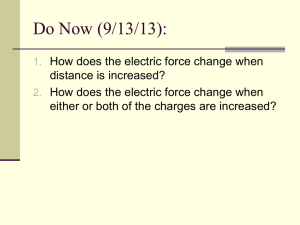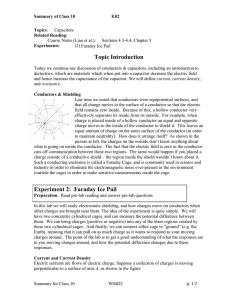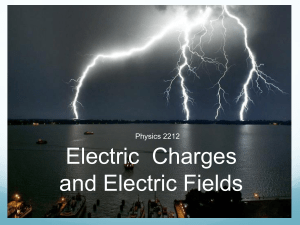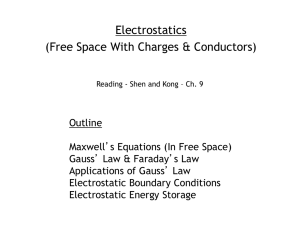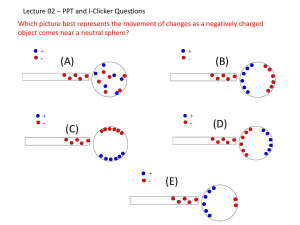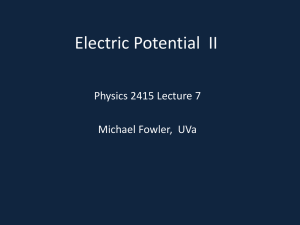pptx
advertisement
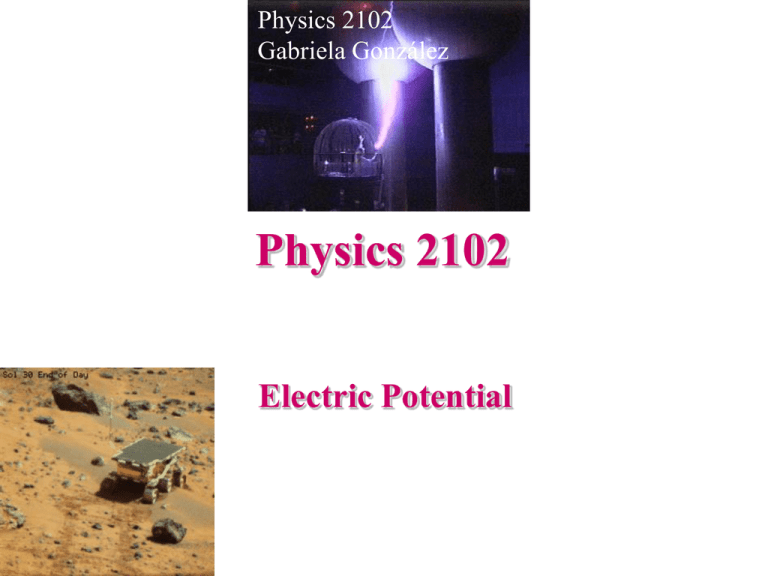
Physics 2102 Gabriela González Physics 2102 Electric Potential Electric Potential on Perpendicular Bisector of Dipole You bring a charge of -3C from infinity to a point P on the perpendicular bisector of a dipole as shown. Is the work that you do: a)Positive? b)Negative? c)Zero? a -Q +Q P -3C Electric Potential of Many Point Charges What is the electric potential at the center of each circle? • Potential is a SCALAR • All charges are equidistant from each center, hence contribution from each charge has same magnitude: V • +Q has positive contribution • -Q has negative contribution A: -2V+3V = +V B: -5V+2V = -3V C: -2V+2V = 0 Note that the electric field at the center is a vector, and is NOT zero for C! -Q A B C +Q Continuous Charge Distributions • Divide the charge distribution into differential elements • Write down an expression for potential from a typical element -- treat as point charge • Integrate! • Simple example: circular rod of radius R, total charge Q; find V at center. R dq V 1 4 0 dq 4 0 R Q dq R 4 0 R Potential of Continuous Charge Distribution: Example • • • • Uniformly charged rod q/L Total charge q Length L kdq What is V at position P V shown? r x P dq dx L k dx (L a x) 0 k ln( L a x ) L 0 dx L a L a V k ln a Summary so far: • Electric potential: work needed to bring +1C from infinity; units = V • Work needed to bring a charge from infinity is W=qV • Electric potential is a scalar -- add contributions from individual point charges • We calculated the electric potential produced: – by a single charge: V=kq/r, – by several charges using superposition, and – by a continuous distribution using integrals. Electric Field & Potential: A Neat Relationship! Notice the following: • Point charge: – E = kQ/r2 – V = kQ/r • Dipole (far away): – E ~ kp/r3 – V ~ kp/r2 • E is given by a DERIVATIVE of V! Focus only on a simple case: electric field that points along +x axis but whose magnitude varies with x. Ex dV dx Note: • MINUS sign! • Units for E -VOLTS/METER (V/m) Electric Field & Potential: Example • Hollow metal sphere of radius R has a charge +q • Which of the following is the electric potential V as a function of distance r from center of sphere? V (a) 1 V (b) r (c) r=R 1 r r=R r 1 r r r=R V +q r Electric Field & Potential: Example +q Outside the sphere: • Replace by point charge! Inside the sphere: • E =0 (Gauss’ Law) dV kQ • → V=constant E 2 dr E 1 r 2 r V E dr kQ r 2 kQ r V 1 r Potential inside? At r = R, V = kQ/R For r < R, V = kQ/R. dr Potential Energy of A System of Charges • 4 point charges (each +Q) are connected by strings, forming a square of side L • If all four strings suddenly snap, what is the kinetic energy of each charge when they are very far apart? • Use conservation of energy: – Final kinetic energy of all four charges = initial potential energy stored = energy required to assemble the system of charges +Q +Q +Q +Q Do this from scratch! Understand, not memorize the formula in the book! Potential Energy of A System of Charges: Solution • No energy needed to bring in first charge: U1=0 +Q +Q +Q +Q • Energy needed to bring in 2 kQ 2nd charge: U Q V 2 1 L • Energy needed to bring in 3rd charge = U 3 Q V Q (V1 V 2 ) kQ 2 kQ L 2 2L • Energy needed to bring in 4th charge = U 4 Q V Q (V1 V 2 V 3 ) 2 kQ L 2 kQ 2 2L Total potential energy is sum of all the individual terms shown on left hand side = kQ 2 4 2 L So, final kinetic energy of each 2 charge = kQ 4 2 4L Equipotentials and Conductors • Conducting surfaces are EQUIPOTENTIALs • At surface of conductor, E is normal to surface • Hence, no work needed to move a charge from one point on a conductor surface to another • Therefore, electric potential is constant on the surface of conductors. • Equipotentials are normal to E, so they follow the shape of the conductor near the surface. • Inside the conductor, E=0: therefore, potential is constant. Potential is not necessarily zero! It is equal to the potential on the surface. Conductors change the field around them! An uncharged conductor: A uniform electric field: An uncharged conductor in the initially uniform electric field: “Sharp”conductors • Charge density is higher at conductor surfaces that have small radius of curvature • E = s/0 for a conductor, hence STRONGER electric fields at sharply curved surfaces! • Used for attracting or getting rid of charge: – lightning rods – Van de Graaf -- metal brush transfers charge from rubber belt – Mars pathfinder mission -tungsten points used to get rid of accumulated charge on rover (electric breakdown on Mars occurs at ~100 V/m) (NASA) Summary: • Electric field and electric potential: E= dV/dx • Electric potential energy: work used to build the system, charge by charge. Use W=qV for each charge. • Conductors: the charges move to make their surface equipotentials. • Charge density and electric field are higher on sharp points of conductors.
